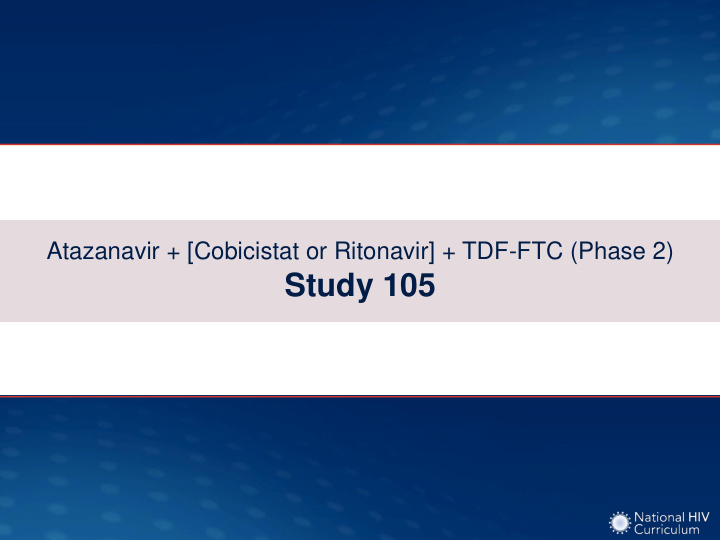



Atazanavir + [Cobicistat or Ritonavir] + TDF-FTC (Phase 2) Study 105
Atazanavir + [Cobicistat or Ritonavir] + TDF-FTC (Phase 2) Study 105: Study Design Study Design: 105 • Background : Randomized, partially placebo- controlled, double-blind phase 2 trial to compare the safety and efficacy of cobicistat and ritonavir as pharmacokinetic enhancers administered with Atazanavir-cobicistat + atazanavir and fixed-dose tenofovir DF- Tenofovir DF-Emtricitabine emtricitabine in treatment-naïve adults with HIV (n = 50) infection 2x • Inclusion Criteria (n = 85) 1x - Age ≥18 - Antiretroviral treatment-naïve Atazanavir + Ritonavir + - HIV RNA ≥ 5000 copies/ml Tenofovir DF-Emtricitabine - CD4 count >50 cells/mm 3 (n = 29) • Treatment Arms (all once daily) - Atazanavir-cobicistat (300/150 mg) + TDF-FTC - Atazanavir 300 mg + Ritonavir 100 mg + TDF-FTC Source: Elion R, et al. AIDS. 2011;25:1881-6.
Atazanavir + [Cobicistat or Ritonavir] + TDF-FTC (Phase 2) Study 105: Results Week 24 and 48: Virologic Response (ITT, Missing=Failure) Atazanavir-cobicistat + TDF-FTC Atazanavir + Ritonavir + TDF-FTC 100 86 86 HIV RNA <50 copies/mL (%) 84 82 80 60 40 20 0 24 Weeks 48 Weeks Study Week Source: Elion R, et al. AIDS. 2011;25:1881-6.
Atazanavir + [Cobicistat or Ritonavir] + TDF-FTC (Phase 2) Study 105: Results Adverse Events and Treatment Discontinuations Atazanavir/cobicistat + FTC-TDF Atazanavir/ritonavir + FTC-TDF 100 100 96 80 Patients (%) 60 48 36 40 17 20 14 4 3 0 Treatment-related Treatment Ocular Hyperbilirubinemia AEs discontinuation icterus/jaundice due to AEs Source: Elion R, et al. AIDS. 2011;25:1881-6.
Atazanavir + [Cobicistat or Ritonavir] + TDF-FTC (Phase 2) Study 105: Conclusions Conclusion : “Using cobicistat and ritonavir as pharmacoenhancers for atazanavir and administered with emtricitabine/tenofovir DF achieved comparable rates of virologic suppression and CD4 cell count increase with satisfactory safety profiles.” Source: Elion R, et al. AIDS. 2011;25:1881-6.
Acknowledgment The National HIV Curriculum is an AIDS Education and Training Center (AETC) Program resource funded by the United States Health Resources and Services Administration. The project is led by the University of Washington and the AETC National Coordinating Resource Center. The content in this slide set does not represent the official views of the U.S. Department of Health and Human Services, Health Resources & Services Administration.
Recommend
More recommend